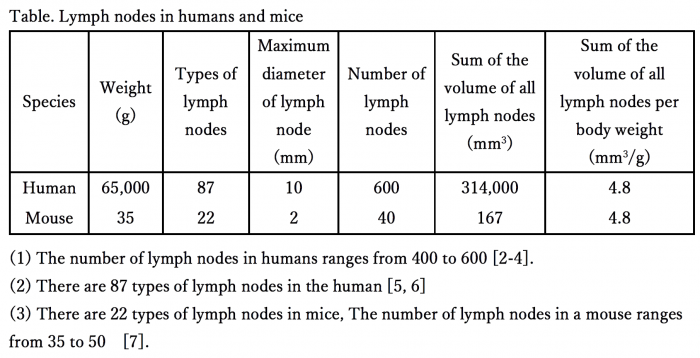Lymph nodes in humans and mice
2021.04.01 note
Is the immune system the same in humans and mice?
Lymph nodes are located at key points in the lymphatic network of the human body and are similar in shape to beans, with a diameter of about 10 mm. They are secondary lymphoid organs in which immune cells are concentrated.
Lymph nodes serve as a barrier to stop and eliminate foreign substances such as bacteria, viruses and cancer cells.
In both humans and mice, the sum of the volumes of all the lymph nodes divided by the body weight has the same value.
When we examine the metabolic rate, food intake, number of animals per area, and the area in which sedentary animals normally move among species, we find that there is a relationship between each value and body weight [1].
It may be possible to derive an equation relating immunity and body weight in different species.
It may well be that organisms with lymph nodes have the same immunity value.

References
[1] T. Motokawa, Elephant Time Rat Time, 74 ed., Chuokoron-shinsha, Tokyo, 2017.
[2] A.L. Mescher, L.C.U. Junqueira, Junqueira’s basic histology : text and atlas, 14th ed., McGraw-Hill Education2016.
[3] Wikipedia, List of lymph nodes of the human body, 2020.
[4] C.L. Willard-Mack, Normal structure, function, and histology of lymph nodes, Toxicol Pathol, 34 (2006) 409-424.
[5] Japan Society of Clinical Oncology, Clinical Practice Guideline, 2021.
[6] U. Kaneko, K. Kaneko, M. Akita, Japanese Human Anatomy, 19th ed., Nanzando, Tokyo, 2012.
[7] L. Shao, S. Mori, Y. Yagishita, T. Okuno, Y. Hatakeyama, T. Sato, T. Kodama, Lymphatic mapping of mice with systemic lymphoproliferative disorder: usefulness as an inter-lymph node metastasis model of cancer, Journal of immunological methods, 389 (2013) 69-78.